
Guide to mitigating spacecraft charging effects
Garrett, Henry B.
Whittlesey, Albert C.
INDICE: Note from the Series Editor xiForeword xiiiPreface xv1 Introduction12 Introduction to the Physics of Charging and Discharging 62.1 Physical Concepts, 62.1.1 Plasma, 62.1.2 Penetration, 82.1.3 Charge Deposition, 102.1.4 Conductivity and Grounding, 112.1.5 Breakdown Voltage, 112.1.6 Dielectric Constant, 122.1.7 Shielding Density, 122.1.8 Electron Fluxes (Fluences) at Breakdown,122.2 Electron Environment, 132.2.1 Units, 142.2.2 Substorm Environment Specifications, 152.3 Modeling Spacecraft Charging, 162.3.1 The Physics of Surface Charging, 172.3.2 The Physics of Dielectric Charging, 192.4 Discharge Characteristics, 192.4.1 Dielectric Surface Breakdowns, 212.4.2 Buried (Internal) Charge Breakdowns, 222.4.3 Spacecraft-to-Space Breakdowns, 222.5 Coupling Models, 232.5.1 Lumped-Element Modeling, 232.5.2 Electromagnetic Coupling Models, 233 Spacecraft Design Guidelines 263.1 Processes, 263.1.1 Introduction, 263.1.2 Design, 273.1.3 Analysis, 283.1.4 Testing and Measurement, 283.1.5 Inspection, 293.2 Design Guidelines, 293.2.1 General ESD Design Guidelines, 293.2.2 SurfaceESD Design Guidelines, Excluding Solar Arrays, 403.2.3 Internal ESD Design Guidelines, 413.2.4 Solar Array ESD Design Guidelines, 443.2.5 Special Situations ESD Design Guidelines, 544 Spacecraft Test Techniques 624.1 Test Philosophy,624.2 Simulation of Parameters, 634.3 General Test Methods, 644.3.1 ESD-Generating Equipment, 644.3.2 Methods of ESD Applications, 685 Control and Monitoring Techniques 765.1 Active Spacecraft Charge Control, 765.2 Environmental and Event Monitors, 766 Material Notes and Tables 796.1 Dielectric Material List, 796.2 Conductor Material List, 80A Nomenclature 83A.1 Constants and Measurement Units, 83A.2 Acronyms and Abbreviations, 84A.3 Defined Terms, 89A.4 Variables, 92A.5 Symbols, 93B The Space Environment 95B.1 Introduction to Space Environments, 95B.1.1 Quantitative Representations of the Space Environment, 95B.1.2Data Sources, 99B.2 Geosynchronous Environments, 102B.2.1 Geosynchronous Plasma Environments, 102B.2.2 Geosynchronous High-Energy Environments, 104B.3 Other Earth Environments, 110B.3.1 MEO, 110B.3.2 PEO, 111B.3.3 Molniya Orbit, 112B.4 Other Space Environments, 112B.4.1 Solar Wind, 112B.4.2 Earth, Jupiter, andSaturn Magnetospheres Compared, 113C Environment, Electron Transport, and Spacecraft Charging Computer Codes 122C.1 Environment Codes, 122C.1.1 AE8/AP8, 122C.1.2 CRRES, 122C.1.3 Flux Model for Internal Charging (FLUMIC), 123C.1.4 GIRE/SATRAD, 123C.1.5 Handbook of Geophysics and the Space Environment, 123C.1.6 L2 Charged Particle Environment (L2-CPE), 123C.1.7 MIL-STD-1809, Space Environment for USAF Space Vehicles, 123C.1.8 Geosynchronous Plasma Model, 124C.1.9 Others, 124C.2 Transport Codes, 124C.2.1 Cosmic Ray Effects on MicroElectronics1996 (CREME96), 124C.2.2 EGS4, 125C.2.3 Geant4, 125C.2.4 Integrated TIGER Series (ITS), 125C.2.5 MCNP/MCNPE, 126C.2.6 NOVICE, 126C.2.7 NUMIT, 126C.2.8 SHIELDOSE, 127C.2.9 SPENVIS/DICTAT, 127C.2.10 TRIM, 127C.2.11 Summary, 128C.3 Charging Codes, 128C.3.1 Environment Work Bench (EWB), 128C.3.2 Multi-Utility Spacecraft Charging Analysis Tool (MUSCAT), 128C.3.3 Nascap-2k and NASCAP Family of Charging Codes, 129C.3.4 SEE Interactive Spacecraft Charging Handbook, 129C.3.5 Spacecraft Plasma Interaction System (SPIS), 129D Internal Charging Analyses 132D.1 The Physics of Dielectric Charging, 132D.2 Simple Internal Charging Analysis, 134D.3 Detailed Analysis, 135D.4 Spacecraft Level Analysis, 136D.4.1Dose-to-Fluence Approximation, 136E Test Methods 138E.1 Electron-Beam Tests, 138E.2 Dielectric Strength/Breakdown Voltage, 139E.3 Resistivity–Conductivity Determination, 140E.4 Simple Volume Resistivity Measurement, 141E.5 Electron-Beam Resistivity Test Method, 142E.6 NonContacting Voltmeter Resistivity Test Method, 143E.7 Dielectric Constant, Time Constant, 144E.8 Vzap Test [MIL-STD-883G, Method 3015.7 Human Body Model (HBM)], 145E.9 Transient Susceptibility Tests, 146E.10 Component/Assembly Testing, 148E.11 Surface Charging ESD Test Environments, 148E.12 System Internal ESD Testing, 148F Voyager SEMCAP Analysis 150G Simple Approximations: Spacecraft Surface Charging Equations 152H Derivation of Rule Limiting Open-Circuit Board Area 156I Expanded Worst-Case Geosynchronous Earth Environments Descriptions 159J Key Spacecraft Charging Documents 162J.1 U.S. Government Documents, 162J.1.1 DoD, 162J.1.2 NASA, 164J.2 Non-U.S. Government Documents, 166J.2.1 American Society for Testing and Materials(ASTM), 166J.2.2 European Cooperation for Space Standardization (ECSS)/European Handbooks, 166J.2.3 European Space Research and Technology Centre, 167J.2.4Japanese Aerospace Exploration Agency (JAXA), 167J.2.5 Other, 167K List of Figures and Tables 168Index 173
- ISBN: 978-1-118-18645-9
- Editorial: John Wiley & Sons
- Encuadernacion: Cartoné
- Páginas: 194
- Fecha Publicación: 25/05/2012
- Nº Volúmenes: 1
- Idioma: Inglés
